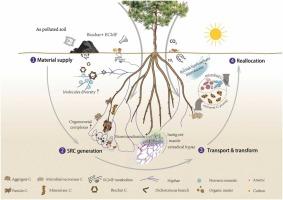Ectomycorrhizal fungi and biochar promote soil recalcitrant carbon increases under arsenic stress
IF 12.2
1区 环境科学与生态学
Q1 ENGINEERING, ENVIRONMENTAL
引用次数: 0
Abstract
Globally, vast mining areas (∼31,396.3 km2) hold significant potential for soil carbon sequestration. However, the sequestration capacity of mine soils is closely linked to contamination characteristics and restoration strategies. Arsenic, a highly toxic metalloid prevalent in acid mine soils, affects carbon turnover through its interactions with soil compounds. Nevertheless, the underlying mechanisms remain inadequately understood. This study introduces a phytobial remediation approach combining ectomycorrhizal fungus (Suillus luteus) inoculated into Pinus massoniana and biochar as a soil amendment. Results demonstrated that S. luteus extended apoplastic spaces to absorb arsenic into root cell intervals while encapsulating organic matter into aggregates. Biochar further promoted recalcitrant carbon formation, significantly increasing aggregate-carbon, particulate organic carbon (POC), and mineral-associated organic carbon (MAOC) by 3.15-, 1.74-, and 2.33-fold, respectively, compared to controls. Distinct hyphosphere microbiomes were observed in the combined treatment (BS), with enhanced microbial diversity, enzyme activity, carbon-sequestration genes, and necromass production, indicating the pivotal role of soil microorganisms in stable carbon pool formation. These synergistic effects not only facilitated arsenic detoxification but also significantly contributed to carbon stabilization.

求助全文
约1分钟内获得全文
求助全文
来源期刊

Journal of Hazardous Materials
工程技术-工程:环境
CiteScore
25.40
自引率
5.90%
发文量
3059
审稿时长
58 days
期刊介绍:
The Journal of Hazardous Materials serves as a global platform for promoting cutting-edge research in the field of Environmental Science and Engineering. Our publication features a wide range of articles, including full-length research papers, review articles, and perspectives, with the aim of enhancing our understanding of the dangers and risks associated with various materials concerning public health and the environment. It is important to note that the term "environmental contaminants" refers specifically to substances that pose hazardous effects through contamination, while excluding those that do not have such impacts on the environment or human health. Moreover, we emphasize the distinction between wastes and hazardous materials in order to provide further clarity on the scope of the journal. We have a keen interest in exploring specific compounds and microbial agents that have adverse effects on the environment.
 求助内容:
求助内容: 应助结果提醒方式:
应助结果提醒方式:


